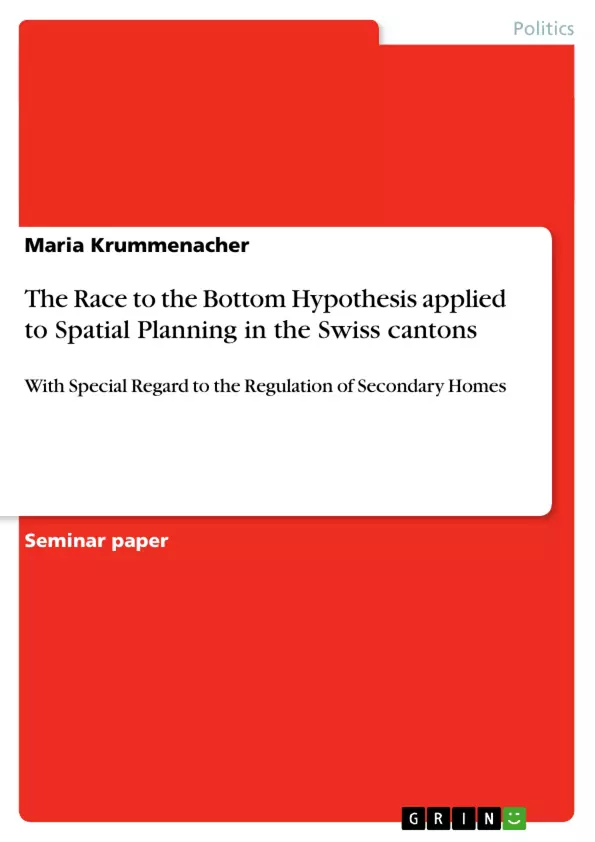It is an ongoing discussion in the political science literature whether a federalist country rather provides a valuable setting for policy experimentation in the subnational entities or whether too much autonomy leads to destructive competition among them. One often mentioned and tested approach to the field is the race to the bottom hypothesis. In this seminar paper the race to the bottom hypothesis will be tested for land use policy and therein the regulation of secondary residences in Switzerland.
The broader frame for the study is provided through the people ́s legislative initiative on the federal level on secondary residences, the Zweitwohnungsinitiative. It has been submitted to a popular vote in Switzerland on 11 March 2012 and succeeded with a razor-thin majority of 50.6 % of total votes. The initiative demands that the share of secondary residences in the Swiss communities can not exceed 20 % of the total number of residences. In those communities that already have a higher share an immediate building freeze has to be enacted. Longchamp et al. showed that the share of secondary residences in a community is a good explanatory for the result of the popular vote. Those communities with a share already higher than 20 % mostly voted no, while the communities with less secondary residences rather voted yes. Hence, one can argue that those parts of Switzerland that will not be heavily affected by the implementation of the initiative imposed the building limitation on those parts that effectively will be. The direct democratic structure of Switzerland enables in it ́s extremes an unaffected majority to dictate policies to a highly affected minority.
The paper will start with an introduction into the basic assumptions and implications of the race to the bottom hypothesis and point out the theoretical suggestions how a race to the bottom between subnational entities can be overcome (Chapter 2). Chapter 3 provides the empirical evidence in favour and against a race to the bottom in land use policy among the Swiss cantons. Building on the data we will be able to assess the overall robustness of the hypothesis for the regulation of secondary residences in Switzerland. Chapter 4 concludes with a resume of the findings, possible explanations and a classification of the Zweitwohnungsinitiative in the field.
Inhaltsverzeichnis (Table of Contents)
- Introduction
- Race to the Bottom Hypothesis
- What does the race to the bottom hypothesis say?
- Factors influencing the probability of a race to the bottom
- Remedies for a race to the bottom
- Linguistic ambiguity
- Evidence from Switzerland
- Defining bottom for land use policy
- Presenting the evidence
- Characteristics of secondary residences
- Correlation between share of secondary residences and income
- Characteristics of land use policy
- Reducing cantonal expenditures for land use policy
- Tax policy
- Mobility of capital and labour
- Share of cantonal GDP of the secondary residence sector
- Relative influence of pro-secondary residence lobby groups
- Conclusion
Zielsetzung und Themenschwerpunkte (Objectives and Key Themes)
This seminar paper explores the race to the bottom hypothesis in the context of land use policy, specifically regarding the regulation of secondary residences in Switzerland. It aims to test the hypothesis by applying indicators developed for air pollution policy in the Canadian Federation, while considering the specific context of Switzerland. The paper focuses on the implications of this hypothesis for spatial planning and the potential impact on cantonal autonomy. Key themes explored in this paper include:- The application of the race to the bottom hypothesis to land use policy
- The role of cantonal autonomy in environmental and climate policy
- The impact of secondary residences on spatial planning and economic development
- The influence of lobbying groups on cantonal land use policies
- The potential for destructive competition among cantons in Switzerland.
Zusammenfassung der Kapitel (Chapter Summaries)
The paper begins with an introduction that sets the context for the study, exploring the debate surrounding federalism and policy experimentation in subnational entities. The introduction also introduces the race to the bottom hypothesis and its application to various policy areas, including environmental policy. The paper further defines secondary residences and their characteristics, providing the background for the analysis. Chapter 2 delves into the race to the bottom hypothesis, outlining its key aspects and the factors influencing its occurrence. It examines potential remedies for a race to the bottom and explores linguistic ambiguity surrounding the concept. Chapter 3 presents evidence from Switzerland, focusing on the regulation of secondary residences. The chapter analyzes the correlation between the share of secondary residences and income, explores various aspects of land use policy, and investigates the influence of factors such as capital and labor mobility, as well as lobbying groups.Schlüsselwörter (Keywords)
The key words and focus topics of this paper include race to the bottom hypothesis, land use policy, secondary residences, cantonal autonomy, spatial planning, environmental policy, Swiss cantons, lobby groups, and destructive competition. The paper analyzes these concepts in the context of Switzerland, focusing on the implications for cantonal decision-making and the impact of secondary residences on the Swiss landscape and economy.- Quote paper
- Maria Krummenacher (Author), 2013, The Race to the Bottom Hypothesis applied to Spatial Planning in the Swiss cantons, Munich, GRIN Verlag, https://www.grin.com/document/231265



